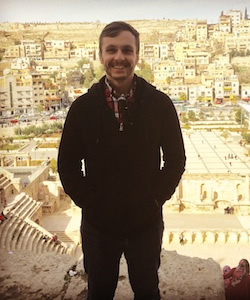Since coming to Amman, some of the most striking and important adventures are taxi rides. Commuting by taxi is, in my mind, a quintessential experience for any visitor to Amman. Driving through the city, whether in bumper to bumper traffic or on wide open roads, is the best way to understand the culture and ambiance of the city in a nutshell from the comfort of a worn car seat.
Entering a cab, it’s customary to exchange multiple greetings with your taxi driver, asking several variations on "How are you?" and replying with compliments—a key highlight of Jordanian hospitality. I’ve received unparalleled courtesy and warmth from locals at every meeting: from the restaurant owner helping me order chicken shawarma sandwich in jumbled Arabic to the stranger giving me directions to a popular cafe. The kindness and care for others exudes from every Jordanian I’ve met on the street, best exemplified by an extremely common greeting in Arabic: "Ahlan wa Sahlan," or "hello and welcome" in English.
The architectural and urban beauty of Amman and striking disparities between East and West Amman are also apparent from the passenger’s seat. While the city began in what is now East Amman, it soon expanded westward. As a result, the eastern part of the city is the most densely packed by buildings and incredible historical sites, while the western half contains larger estates less densely packed in. A city of many hills, Amman offers incredible views of the skyline and surrounding city at almost any location. The city itself has a rich history. It has been inhabited on and off since 7250 BCE, with populations living in the surrounding area since the Neolithic period. Under rule from the Ammonites, Greeks, Romans, and Umayyads at different times, Amman has a diverse array of architecture and beautiful ruins exemplified by the Amman Citadel, or Jabal al-Qal’a in Arabic.
Perhaps more interesting than anything else is the driving culture in Amman. Major streets are often congested like in other major cities, and driving rules vary a great deal from those in the United States. I’ve found that there are a number of different reasons that people will honk their horns in the car: to signal pedestrians to walk, to alert cars that they’ll be crossing an unregulated intersection, to allow other drivers to merge into their lane (or warn other drivers of their presence—a difficult distinction to make!), among many, many more. Gas is also surprisingly cheap in Amman, keeping the cost of riding in taxis affordable for all. A 6-mile ride costs approximately $3, an unfathomably low price when compared to a ride in Washington, D.C.! There seems to be a language of the road that all drivers subconsciously understand. A country of over six million residents and millions more guests (including refugees), the city itself serves as a metropolis perfectly positioned in the country’s northeast.
Yet perhaps the best part of the cab ride, apart from the conversation and beautiful scenery, is arriving at your final destination in a city overflowing with life, culture, and wonder. I can’t wait to see what the coming months bring, but I have a feeling it’ll be incredibly exciting and rewarding.

